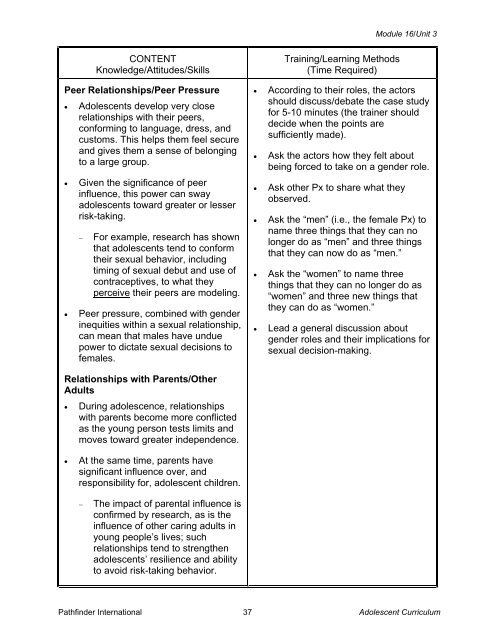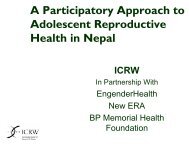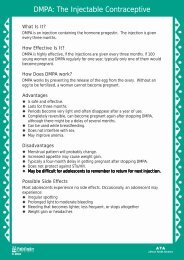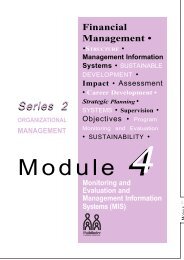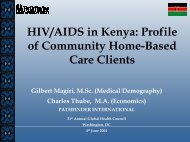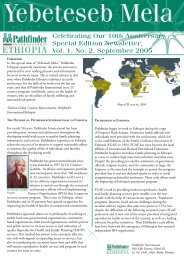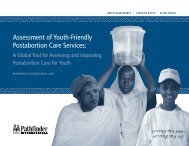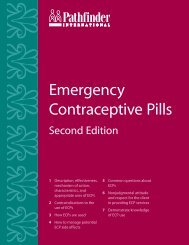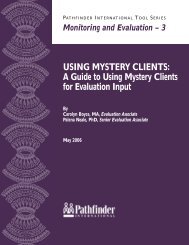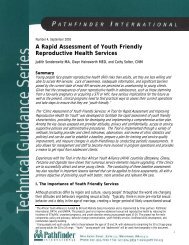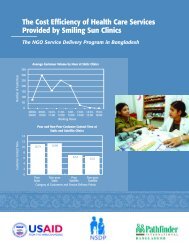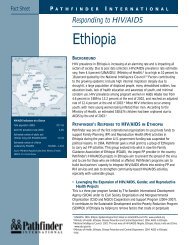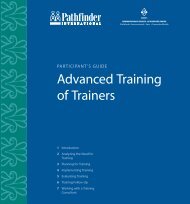reproductive health services for adolescents - Pathfinder International
reproductive health services for adolescents - Pathfinder International
reproductive health services for adolescents - Pathfinder International
You also want an ePaper? Increase the reach of your titles
YUMPU automatically turns print PDFs into web optimized ePapers that Google loves.
Module 16/Unit 3<br />
CONTENT<br />
Knowledge/Attitudes/Skills<br />
Peer Relationships/Peer Pressure<br />
• Adolescents develop very close<br />
relationships with their peers,<br />
con<strong>for</strong>ming to language, dress, and<br />
customs. This helps them feel secure<br />
and gives them a sense of belonging<br />
to a large group.<br />
• Given the significance of peer<br />
influence, this power can sway<br />
<strong>adolescents</strong> toward greater or lesser<br />
risk-taking.<br />
−<br />
For example, research has shown<br />
that <strong>adolescents</strong> tend to con<strong>for</strong>m<br />
their sexual behavior, including<br />
timing of sexual debut and use of<br />
contraceptives, to what they<br />
perceive their peers are modeling.<br />
• Peer pressure, combined with gender<br />
inequities within a sexual relationship,<br />
can mean that males have undue<br />
power to dictate sexual decisions to<br />
females.<br />
Training/Learning Methods<br />
(Time Required)<br />
• According to their roles, the actors<br />
should discuss/debate the case study<br />
<strong>for</strong> 5-10 minutes (the trainer should<br />
decide when the points are<br />
sufficiently made).<br />
• Ask the actors how they felt about<br />
being <strong>for</strong>ced to take on a gender role.<br />
• Ask other Px to share what they<br />
observed.<br />
• Ask the “men” (i.e., the female Px) to<br />
name three things that they can no<br />
longer do as “men” and three things<br />
that they can now do as “men.”<br />
• Ask the “women” to name three<br />
things that they can no longer do as<br />
“women” and three new things that<br />
they can do as “women.”<br />
• Lead a general discussion about<br />
gender roles and their implications <strong>for</strong><br />
sexual decision-making.<br />
Relationships with Parents/Other<br />
Adults<br />
• During adolescence, relationships<br />
with parents become more conflicted<br />
as the young person tests limits and<br />
moves toward greater independence.<br />
• At the same time, parents have<br />
significant influence over, and<br />
responsibility <strong>for</strong>, adolescent children.<br />
−<br />
The impact of parental influence is<br />
confirmed by research, as is the<br />
influence of other caring adults in<br />
young people’s lives; such<br />
relationships tend to strengthen<br />
<strong>adolescents</strong>’ resilience and ability<br />
to avoid risk-taking behavior.<br />
<strong>Pathfinder</strong> <strong>International</strong><br />
37<br />
Adolescent Curriculum


